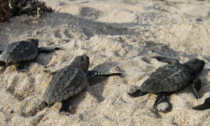
For millions of years, countless sea turtles navigated the world’s oceans, migrating vast distances between foraging sites and natal nesting beaches. But today, those long journeys repeatedly expose them to harmful anthropogenic impacts and disruptive environmental changes. And despite worldwide conservation efforts, all seven sea turtle species are endangered or critically endangered at global or regional levels.
The mass movement of these, and other animals, by land, sea or air, represents one of Earth’s ancient rhythms and one of its great wonders. Those migrations also weave together vital living threads that strengthen ecosystem structure.
Now, for myriad reasons — including human-made physical hazards, climate change, pollution, habitat loss, and much more — the frayed fabric of those global eco-structures is shredding fast. Species are disappearing at unprecedented rates and biodiversity loss is irrevocably altering natural systems, imposing adverse impacts on the world’s migrators.
The burning question: can sea turtles, people and conservation strategies evolve fast enough to protect the world’s epic migrations and the animals that make them?

Crossing planetary boundaries poses multiple threats
Biodiversity is just one of nine planetary boundaries that allow a “safe operating space for humanity,” according to an interdisciplinary team of scientists convened by the Stockholm Resilience Centre. The other eight boundaries that humanity must avoid overshooting are climate change, ocean acidification, land-system change, freshwater use, stratospheric ozone depletion, atmospheric aerosol pollution, biogeochemical flows (imbalances in the nitrogen and phosphorus cycles), and the impact of novel entities (such as chemicals, engineered materials or organisms).
Humanity has already breached the “core borders” of biodiversity loss and climate change, and overstepped the bounds of biogeochemical flows and land-system change. While the overshoot of just one core border could completely destabilize the Earth systems that sustain humanity, the crossing of any single boundary also risks destabilizing others— unleashing a domino effect. In coming decades, human activities will put as many as 1 million more plant and animal species at risk of extinction, according to the Intergovernmental Science-Policy Platform on Biodiversity and Ecosystem Services (IPBES) 2019 report.
“Biodiversity and nature’s contributions to people are our common heritage and humanity’s most important life-supporting ‘safety net,’” said Sandra Díaz, an Argentinian ecologist who co-chaired the IPBES in 2019. “But our safety net is stretched almost to breaking point.”
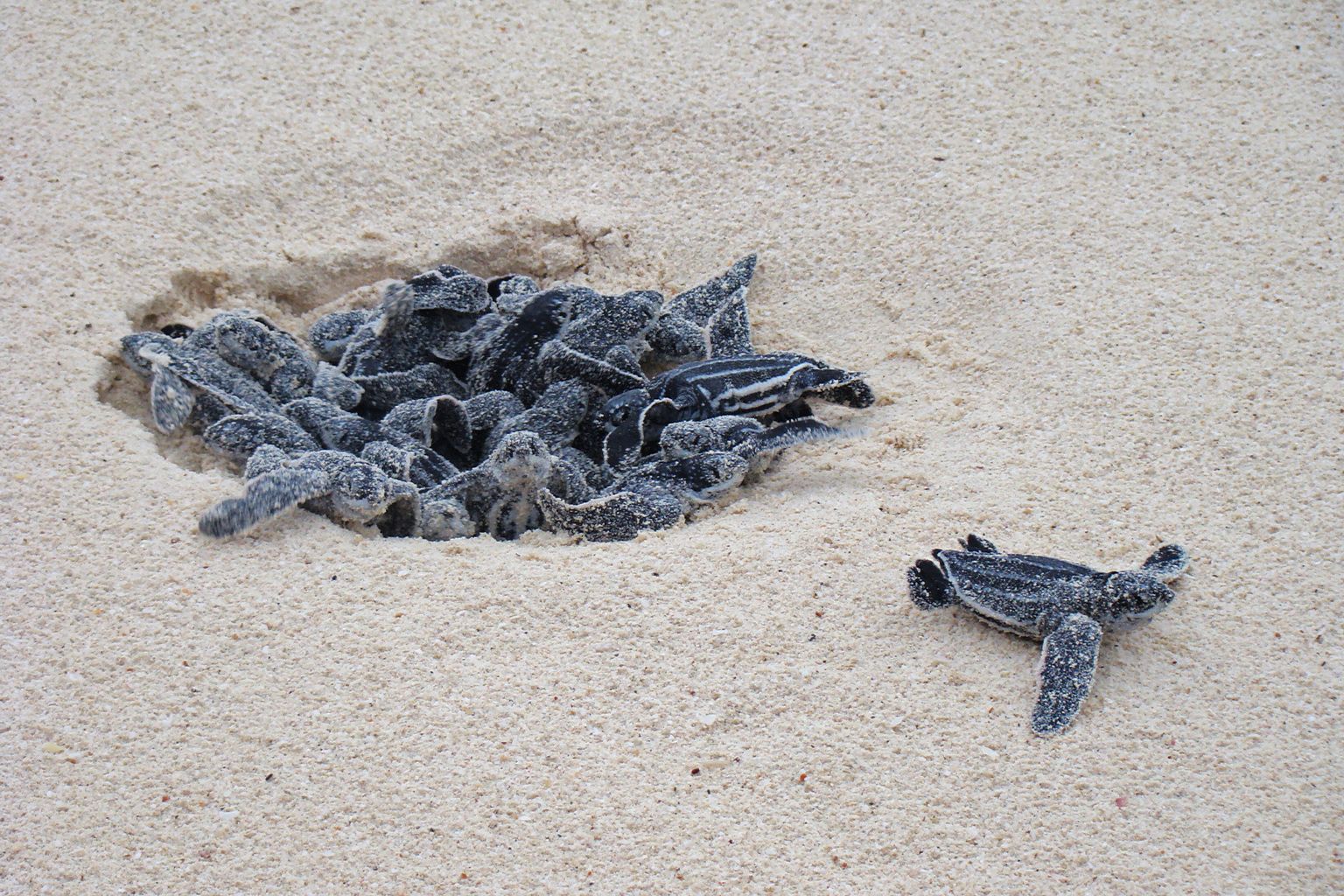
Turtles at added risk due to boundaries overshoot
Sea turtles hold a tenuous and unenviable position in the planetary boundary framework. Their life cycle requires safe passage across sea and land. Leatherback migrations, for example, can traverse the borders of more than 30 countries.
As humanity rapidly approaches the limits of more planetary boundaries, it puts these intrepid mariners increasingly in harm’s way from a variety of sources. If conservation efforts cannot reverse sea turtle losses, their plight could herald extinction for other migratory species, even perhaps for the greatest migrator of all: Homo sapiens.
The best-known environmental threats to sea turtles mostly involve the biodiversity planetary boundary (fisheries bycatch and human take of turtle eggs, for example), and the land-use change boundary (habitat and/or nesting site losses).
But now, redefined within the context of other human planetary boundary transgressions, the turtles face a plethora of poorly understood new hazards, plus looming questions about how conservation can pivot to help.
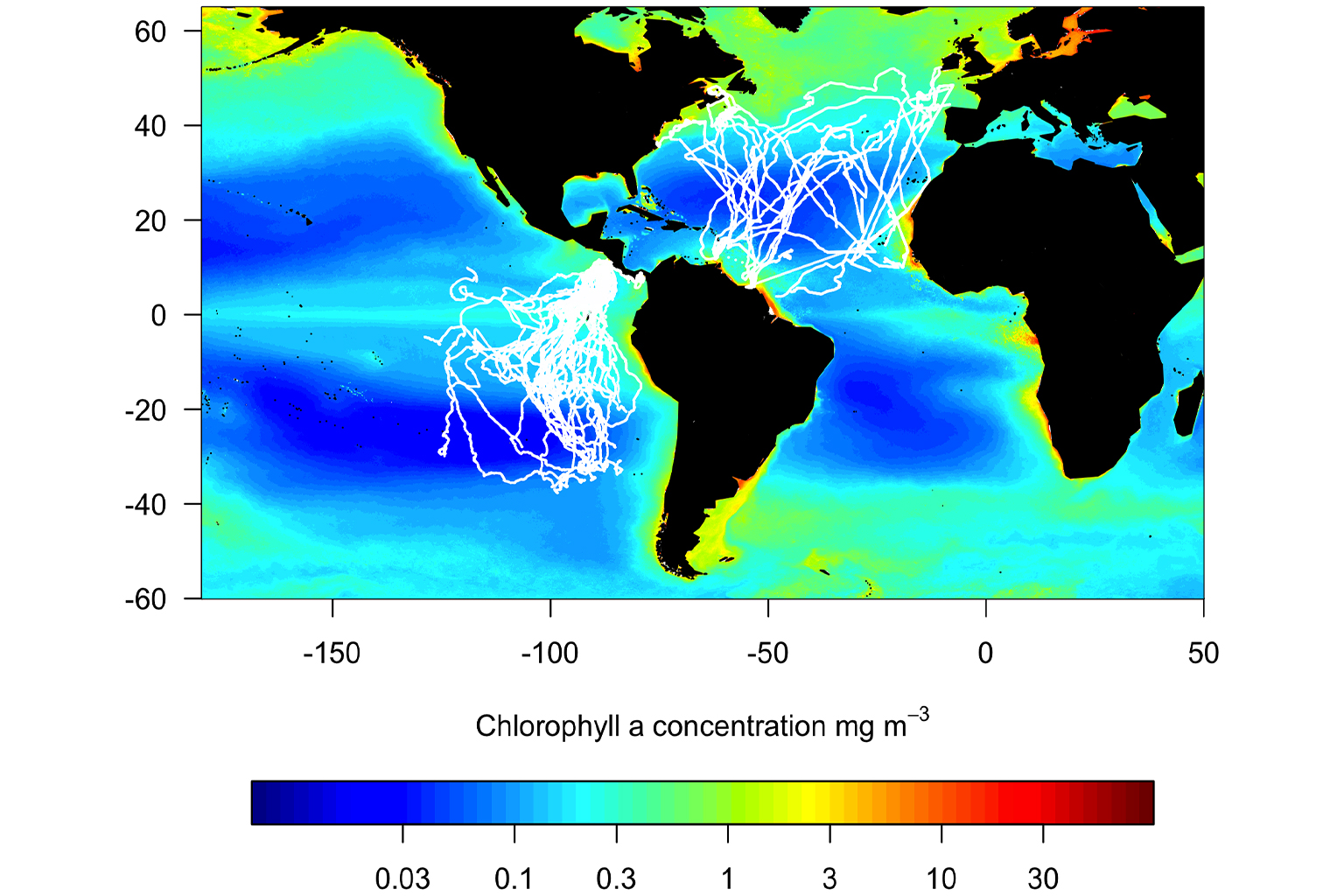
Assault on nesting beaches
Sea turtles are most visible to us when females come ashore to lay eggs, and that’s their habitat most studied by science. Climate change is one planetary boundary already known to be altering the sandy beaches where turtles nest and spend a brief but critical portion of their lives, posing multiple existential challenges. For example, because the sex of sea turtles is temperature dependent, more females are hatching as global warming pushes temperatures higher on the world’s nesting beaches. Today, females outnumber males three to one at many global sites.
“But how is feminization affecting populations?” asks Mariana Fuentes, a Florida State University marine conservation biologist. “How many males do there need to be to sustain populations? We don’t know.”
Novel entities, another planetary boundary, may be acting synergistically with global warming to turn up beach heat even more. Human-made microplastics mingled with nesting sand could be raising sand temperatures higher, says Fuentes, who is studying sand’s evolving thermal profile.
Clearly, all those females will need nesting beaches with optimal incubating environments — a key factor in the resilience of global turtle populations, Fuentes adds. But another boundary, land-use change, is reducing the availability and suitability of nest sites. As climate change escalates, more severe and frequent storms will erode more beaches, and primary nesting sites may disappear. Simultaneously, sea level rise due to climate change and the “armoring” of coastlines with human development, especially sea walls, will make the nesting situation worse.
Turtles have adapted and shifted to new nest areas in the past, but as humanity increasingly blocks beach access, will there be enough suitable nesting places?
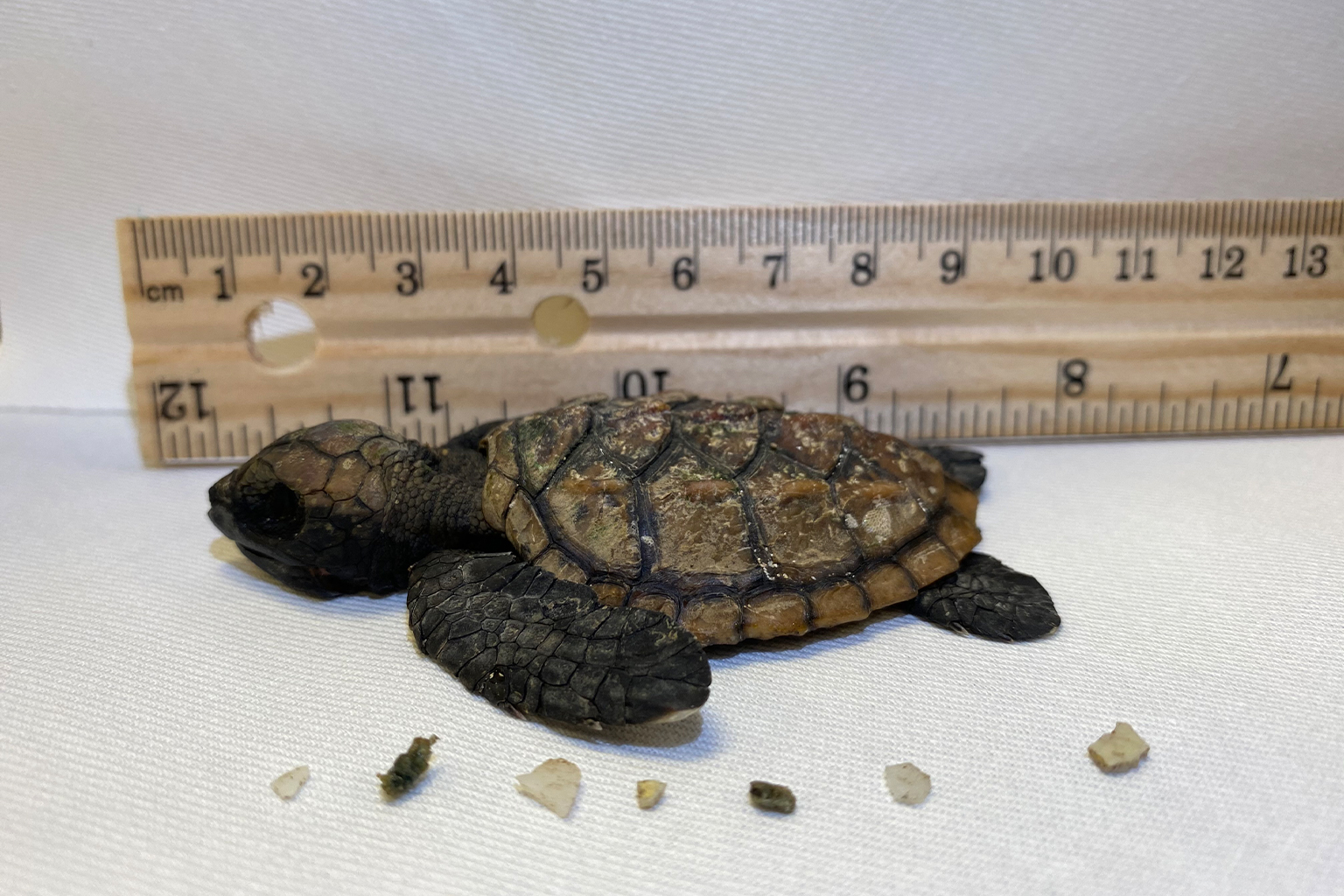

Trouble at sea
Sea turtles spend the bulk of their life cycle at sea. In the oceans, acidification is causing severe losses of the world’s coral reefs and wiping out critical sea turtle rookeries. Studies also predict that reductions in reef species will change the composition of the sand on nesting beaches, potentially reducing successful egg incubation. In addition, increasing seawater acidity due to carbon emissions is causing some fish species to lose their sense of smell, hearing and homing ability. No one yet knows whether sea turtles could be similarly affected.
And although studies show that turtles hear best underwater, there is limited data about their behavioral responses to noise. As offshore wind farm installations to combat climate change become more commonplace, auditory hazards could alter migration routes or other important habitat, Fuentes says. Studies will be needed to find out.
Additionally, oceans are contaminated with an alphabet soup of industrial pollutants. These so-called novel entities include persistent organic pollutants (POPs) such as polychlorinated biphenyls (PCBs), organochlorine pesticides, flame retardants, and a host of other toxicants.
“These are invisible threats [whose impacts] are hard to quantify,” says Jennifer Lynch, a research biologist affiliated with the U.S. National Institute of Standards and Technology.
Meanwhile, industry and society continue flushing thousands of old and new chemicals into the sea, Lynch says. But sick sea turtles might only get tested for a mere dozen of those pollutants. It would be impossible to test for them all, so unknowns are rife: “Is the level of the chemical found in a turtle a toxic dose?” Lynch asks. We’ll probably never know because no one does toxic dosage testing on endangered turtles, she says. “We’ll never get ahead of these [contaminants].”
Even the impacts of oil spills on sea turtles are not well documented. A review of more than 2,000 oil spills worldwide, spanning 60 years, showed that effects on sea turtles were reported in less than 2% of incidents. And most of those documented effects related only to external oiling, not to internal harm from oil exposure, nor the impacts of oil absorbed into beach sand or the effect of chemical dispersants used in cleanups.
As ocean transport increases, novel fuel sources such as diluted bitumen pose potential new toxic perils.


Degraded ecosystems and chronic exposure to chemicals or heavy metals also lower a turtle’s immune defenses. Scientists say weakened immune systems could be playing a role in the development of fibropapillomatosis, a fleshy tumor often lethal to sea turtles.
Among novel entities, plastic pollution continues getting the bulk of media attention. These petroleum-based products contaminate all the world’s oceans with plastic nanoparticles, nylon fishing nets, plastic bags, and heaps of other trash.
“Microplastics make the headlines, but it is the macroplastics that are the top-tier threat to sea turtles,” states Lynch, who has analyzed the contents of hundreds of turtle gastrointestinal tracts in her role as co-director of the Center for Marine Debris Research at Hawai‘i Pacific University. While she routinely sees healthy-looking adult turtles that are “chock full” of plastic debris, the turtles that ingest meters-long monofilament fishing lines can die from twisted intestines. Those long lines can also become garrotes around flippers and necks.
The true extent of plastics harm at sea is very hard to quantify, Lynch says. How many turtles, for example, try to transit the “Great Pacific Garbage Patch” but get entangled and die amid the plastic accumulation? Designing a study to answer that question feels impossible, Lynch adds. “So, the entanglement issue in the scientific literature is published as case studies, [but] case studies do not tell you anything about population level threat.”
Lynch is now laser-focused on reducing plastic pollution in Hawai‘i. One innovative project tracks derelict fishing gear that washes ashore back to the fishery or manufacturer of origin. “If they’re throwing it into the ocean because it’s scrap, then that’s littering,” says Lynch, who hopes the trace-back program can prevent repeat offenses. “We can do something about that!”


Land-system changes are creating water quality problems for sea turtles, too. With increasing deforestation, cropland and pasture expansion by industrial agribusiness, and human development, the amount of sediment runoff and the cycling of nitrogen and phosphorus nutrients are being altered throughout Earth’s natural systems.
Agricultural runoff delivers an especially intense load of nitrogen and phosphorus pollution to the world’s estuaries. These nutrients then “fertilize” the seas and produce huge mats of algae that reduce water oxygen levels to zero, causing the formation of massive dead zones. Dead zones, like the vast one found annually extending far beyond the mouth of the Mississippi River, are on the upswing globally, and even exist in the open ocean. How sea turtles are being affected is unknown.
Surviving the odds: The Eastern Pacific leatherbacks
The litany of threats seems to stack the odds against sea turtles. Yet, olive ridleys (Lepidochelys olivacea) still appear for arribadas (mass nesting events) in India’s Odisha and Maharashtra states; black turtles (a variant of the green sea turtle, Chelonia mydas), have returned by the thousands to Mexican waters; and green sea turtle populations are thriving in Hawai‘i.
These successes arose from decades of dedicated efforts by local communities, regional conservation collaborations, and multinational agreements to protect marine habitats and nesting beaches, prevent egg collecting, reduce fisheries bycatch, and ban the export and sale of turtle products. But success is unevenly distributed around the globe.
The Eastern Pacific leatherback (Dermochelys coriacea), for example, is in a decades-long decline. Since the 1980s, annual counts of nesting leatherbacks and their nests in Mexico and Central America have dropped by more than 90%, according to a 2020 population modeling study by the Laúd OPO Network. Pinpointed chronic losses are occurring due to fisheries bycatch and unsustainable levels of egg collection for human consumption.
But just because success is proving difficult in some regions, that’s no reason to give up, cautions Bryan Wallace, co-coordinator for Laúd OPO, also known as the Eastern Pacific Leatherback Conservation Network. “Just because the population is still on the ropes, doesn’t mean all the previous 30 or 40 years of effort wasn’t effective. We haven’t recovered the population [yet], which no doubt means we’ve got more to do,” he says.

In the face of escalating anthropogenic threats, what is the “more” needed to avoid extinction? Wallace’s forthright answer: the survival of at least 200 more adult or subadult leatherbacks every year — starting within the next five years. His conclusion is based on population modeling scenarios and assumes continued success in protecting nests and hatchlings. Without more reproductive adults, the Eastern Pacific leatherbacks may go extinct in the next few decades.
Altering the way humanity fishes
Wallace makes an important point: Even if a turtle population can adapt to all the new anthropogenic challenges being thrown at it, there still need to be sufficient numbers of adult turtles to mate and survive those impacts: That winning numbers game needs to be a major component of future conservation efforts, according to Fuentes’ research into creating a sea turtle resilience index.
Saving adult turtles begins with a single high priority: preventing fisheries bycatch, long a focal point for conservationists. Recognized solutions include using turtle-friendly fishing gear, teaching fishers how to safely release entangled sea turtles, and restricting fishing along common sea turtle migration routes, while also getting fishing fleets to share information about, and avoid, sea turtle hotspots.
But despite these initiatives, sea turtles, including leatherbacks, spend most of their lives in harm’s way: swimming the global commons of the high seas where most industrial fishing fleets operate — also some of Earth’s least-protected places for marine life. So, targeting conservation toward small-scale fisheries, which account for more than 90% of commercial fishers worldwide that produce nearly 50% of the global catch, could make a big difference.
Joanna Alfaro-Shigueto, co-founder and president of ProDelphinus, a Peru-based NGO, has spent decades working to reduce bycatch by small fisheries along the more than 2,000 kilometers (1,240 miles) of her home country’s coastline.
To make their conservation plans more effective, Alfaro-Shigueto’s team developed a rapid bycatch assessment to fill information gaps. Instead of going to sea and counting actual bycatch, rapid assessments rely on land-based interviews with boat captains and fishers. ProDelphinus’s surveys from 43 ports in Peru, Ecuador and Chile showed that small-scale gillnet fisheries caught more than 46,000 sea turtles — and killed more than 16,000 — every year. The highest counts were in Peru and Ecuador, highlighting where to concentrate conservation work.

The Laúd OPO Network set up workshops to use this assessment method more widely. That led to a leatherback bycatch survey across 79 fishing communities in Mexico, Nicaragua, Costa Rica, Panama and Colombia. Results estimated that a minimum of 345 leatherbacks were caught annually in small-scale fisheries across that region. The survey also found that ports close to nesting beaches were bycatch hotspots, providing a comprehensive regional map as to where the next phase of conservation should focus. Importantly, fishers reported that 80% of captured leatherbacks were released alive, which means teaching people how to safely release animals could improve bycatch survival rates.
Innovative uses of existing technology could also help reduce bycatch. In the eastern tropical Pacific, use of gillnets harmful to turtles by small-scale fisheries is among the highest in the world. ProDelphinus partnered with researchers at the University of Exeter, U.K., to distribute LED lights among three small-scale Peru fisheries. When fishers attached the lights to gillnets, it helped sea turtles avoid them, and bycatch dropped by more than 70%.
Improving on this idea, scientists at Arizona State University, U.S., designed solar-powered lights. When fishers in Baja California Sur, Mexico, put the flashing, self-charging lighted buoys on gillnets, they reduced sea turtle bycatch by 65-70% while maintaining target fish catch, says Jesse Senko, lead researcher and marine conservation scientist. With fewer turtles to disentangle and less net damage to repair, the fishers also saved time. Unfortunately, Senko estimates that mass production of the solar lights may take another five years. The leatherbacks might not be able to wait that long.
“In the big picture, we are not just trying to conserve turtles. We are also trying to promote sustainable fisheries,” says Alfaro-Shigueto. “The challenge now? Conservation is not fast enough and we are running out of time.”

Changing the future of sea turtle conservation
If sea turtles lack the time to adapt, perhaps it’s time for conservation to adapt its methods, say practitioners. For example, there’s a long-running terrestrial bias built into sea turtle research. Most studies are conducted on land where researchers can easily walk about, counting nesting females, eggs or hatchlings. “But that is a tiny sliver or snapshot of their overall lives,” says Kate Mansfield, a sea turtle biologist at the University of Central Florida.
For that reason, relatively little is known about males because they don’t come ashore. Likewise, leatherbacks spend most of their lives in the open ocean, and no one knows where they go during their “lost years,” or what may benefit or impair their survival while there.
“These animals live at least as long as humans. And they occur in different parts of the world at different ages and life stages,” explains Mansfield. “In order to best protect and conserve these species, we really need to know this stuff.”
A recent study, for example, changed scientists’ long-held assumption that young turtles cruise along ocean currents to reach distant forage sites. Mansfield and her colleagues stuck solar-powered tracking devices on juvenile greens. Surprisingly, they found that young turtles deliberately swam out of big currents to get to good foraging habitat provided by seaweed mats in the North Atlantic’s Sargasso Sea — sadly also “one of the dirtiest and most damaged parts of the open ocean.” The gyre of four currents bounding this shoreless sea traps huge amounts of plastic waste; turtle impacts aren’t known.
There are similar knowledge gaps about the journeys subadult and adult leatherbacks make. Now, Mansfield is testing a new tracking technology, called ICARUS, which pings satellite signals off the International Space Station for potentially more accurate turtle tracking.
But much more research is needed. The current dearth of data “would be like having human doctors in hospitals only knowing about, and able to treat, teenagers and older people,” says Mansfield. “It’s really important to understand where these animals are going … because they are ultimately the foundation of the rest of the population.”

Protecting habitat key to turtle conservation
Just keeping tabs on turtles and their movements may miss two essential points for successful future conservation: a focus on habitats and humans.
Species-focused approaches to conservation appeared during the 1960s and ’70s, when turtle extinctions seemed imminent, says Kartik Shanker, an ecologist at the Indian Institute of Science, Bengaluru. “But [since then] we haven’t been able to let go of that [approach] enough.”
In places where populations are recovering, Shanker argues, not enough is being done to safeguard sea turtle habitat, despite ecosystem protections that are part of international agreements, including the Indian Ocean’s Southeast Asian Marine Turtle Memorandum of Understanding, the Inter-American Convention for the Protection and Conservation of Sea Turtles, and the International Commission for the Conservation of Atlantic Tunas.
“When push comes to shove, management and mitigation actions have been species-focused instead of habitat-focused,” Shanker states. “Turtle populations do seem able to bounce back. But what they can’t bounce back from is if [nesting] beaches don’t exist anymore.”
Unfortunately, there’s no perfect strategy for protecting these beaches from human nature, with its penchant for coastal development, or Mother Nature.

“To me, the key [sea turtle] conservation issues are protecting those breeding grounds and eliminating as many marine threats as we can,” says David Godfrey, executive director of the Sea Turtle Conservancy, a Florida-based NGO that monitors major nesting sites in Florida, Costa Rica and Panama, and advocates for policy changes to preserve key habitats.
A key problem: there’s a lot researchers don’t know about the value of potential population and habitat protection initiatives. For example, the outcomes of interventions — such as relocating nests to save them from sea level rise, or the incubation of eggs at cooler temperatures to produce more males — aren’t well understood, Fuentes admits.
With limited resources, it’s important to pinpoint the most effective actions, she urges. “There’s a lot that could be done, but we need to have a better understanding of the tradeoffs or effectiveness, and the return on conservation efforts before implementation.”
Another big blind spot is that threats are typically treated individually, “But we need to be considering the cumulative impacts — the synergies,” says Fuentes.
Whatever scientists discover about sea turtles and their collisions with humanity’s planetary boundary overshoots, it won’t be enough if that knowledge can’t be turned into practical action. “Scientists don’t always know the best way to translate the right information to the right person at the right time to ensure that the best science is used to maximize conservation outcomes,” Fuentes says.
For Godfrey, one of the most important things to know is not just the science, but the people in elected offices: “If you want to protect wildlife and the environment, those people make all the difference.”
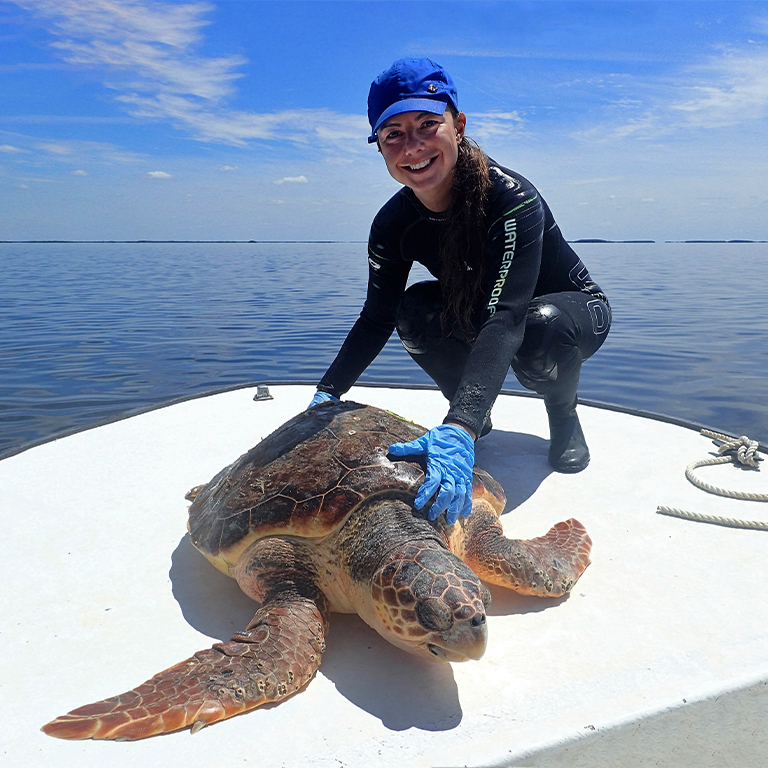
‘There will be another chance’: Embracing traditional points of view
As big as the anthropogenic impacts ahead may be, future conservation successes will still need to rely heavily on engaged individuals and local communities. “We need to be working towards — not severing — the links that people have with nature,” says Shanker, co-founder of Dakshin, an NGO focused on the human side of conservation.
In many situations, he notes, Indigenous resource utilization has been condemned and not considered part of conservation solutions. “It has become culturally embedded that any use of sea turtles is wrong,” a view Shanker says is predominantly Western in origin, but which drives much of global policy. That outlook is entrenched in places like India, he says, where the dominant paradigm is staunchly protectionist toward sea turtles and other species.
Even sustainable use, such as the legal egg harvest in Ostional, Costa Rica, stirs controversy. There, the monthly arribadas of olive ridleys produce so many eggs that community members can collect during the first nesting wave without major harm, while boosting the local economy.
Seeking to better understand what sea turtles mean to communities near nesting areas took marine biologist Jose Urteaga away from the turtle-nesting beaches of Nicaragua to study the social drivers of poaching and resource use at Stanford University in California.
In the 1980s, unsustainable egg harvesting on Nicaragua’s Pacific coast pushed the leatherback population there to collapse. In 2002, with the NGO Fauna & Flora International, Urteaga started working with communities: He trained locals to run an egg hatchery and created a program paying collectors to bring eggs to the hatchery instead of illegal markets. Those efforts expanded to protect nearly 100% of nest sites on three key beaches.
Still, the population continued crashing. In the 2019-20 season, not a single leatherback nest was found on the protected beaches — an impact that hurt both natural and human communities.

During the early years of his conservation work, a memorable conversation with an elder egg trader forever changed Urteaga’s perception about local peoples’ stake in sea turtle survival. “What do the turtles mean to you?” he asked the old woman, confronting her as if she were the enemy. The elder replied:
I’m going to explain to you what these turtles and the ocean mean to me. When my sons were sick and I needed medicine for my sons, the turtles gave me the money to get medicine. When my sons were hungry and they needed food, the turtles gave me the food to feed my children. And when the children needed to go to the school, the turtles gave me the resources to send them to school. So, if that doesn’t tell you how important the turtles are, and what they mean to me, nothing is going to do it.
Years later, at Stanford, Urteaga analyzed the many human factors affecting turtle conservation. He found direct evidence of community commitment to conservation: I n Nicaragua, most local communities that paid incentives offered less money than the illegal market. But Urteaga found that collectors were willing to accept lower payment for the eggs because they viewed it as their contribution to sea turtle conservation.
The need to better understand people may also apply to conservationists themselves, notes Urteaga. Sea turtles, particularly the giant leatherback, are viewed as almost mythical creatures by many practitioners. “They touch some part of our heart, and sometimes we think that conservation, ultimately, is changing the minds and the souls of people in that direction,” he says.
But people in local communities, who live in totally different realities, don’t need to embrace that same mythical mindset to conserve turtles. “We can just agree on the need to protect a resource that is also important for them.”
Today, female leatherbacks are finally returning to the beaches of Nicaragua. Not many. But enough to reaffirm Urteaga’s optimism, an outlook he acquired from the dedicated community people he worked with over the decades. He says they tell him: “There will be another chance. There will be another turtle that will come. There will be another opportunity to protect the nests and to release those hatchlings to the sea.”
Adapting together — turtles and people — the great migrators may be able to continue their epic journeys for ages to come.












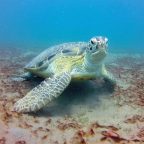
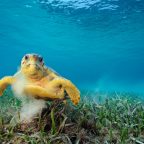
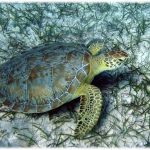


Social Profiles